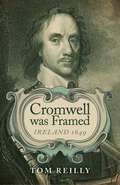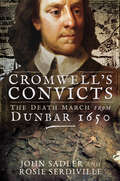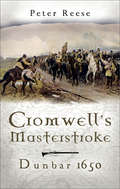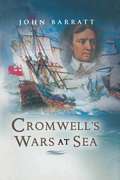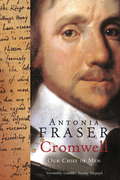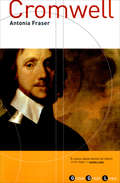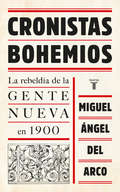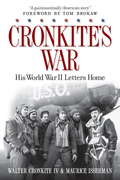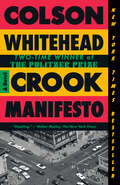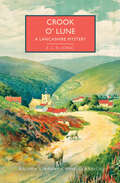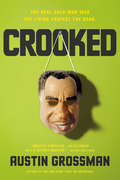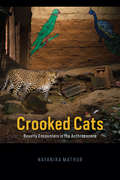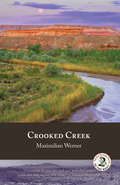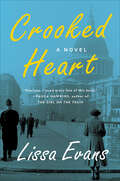- Table View
- List View
Cromwell to Cromwell: Reformation to Civil War
by John SchofieldThe English reformers of the 1530s, with Thomas Cromwell at their head, continued to have a strong belief in kingly rule and authority, in contrast to their radical approach to the power of the Pope and the Roman Catholic Church. Resisting the king was tantamount to resisting God in their eyes, and even on a matter of conscience the will of the king should prevail. Yet just over 100 years later, Charles I was called the 'man of blood', and Oliver Cromwell famously declared that 'we will cut off his head with the crown on it'. But how did we get from the one to the other? How did the deferential Reformation become a regicidal revolution? Following on from his biography of Thomas Cromwell, John Schofield examines how the English character and the way it perceived royal rule changed between the time of Thomas Cromwell and that of his great-great-grandnephew Oliver.
Cromwell was Framed: Ireland 1649
by Tom ReillyThe publication of "Cromwell: An Honourable Enemy" fifteen years ago sparked off a storm of controversy with many historians publically deriding the divisive and groundbreaking study. Dissatisfied with the counter-explanations of these seventeenth-century experts concerning Cromwell&’s complicity in war crimes in Ireland, amateur historian Tom Reilly now throws down the gauntlet to his critics and issues a challenge to professional historians everywhere. In this entirely fresh work Reilly tackles his academic detractors head-on with original and radical insights. Breaking the mould of the genre, for the first time ever, the author publishes the actual contemporary documents (usually the privileged preserve of historians) so the authentic primary source documents can be interpreted at first hand by the general reader, without prejudice. Among the author&’s fresh discoveries is the revelation of the identity of two (unscrupulous) contemporary individuals who, after exhaustive research, seem to be personally responsible for creating the myth that Cromwell deliberately killed unarmed men, women and children at both Drogheda and Wexford, and that a 1649 London newspaper reported that Cromwell&’s penis had been shot off at Drogheda. Whatever your view on Cromwell, this book is persuasive. Conventional wisdom is challenged. Lingering myths are finally dispelled.
Cromwell's Convicts: The Death March from Dunbar 1650
by John Sadler Rosie SerdivilleCromwell's Convicts not only describes the Battle of Dunbar but concentrates on the grim fate of the soldiers taken prisoner after the battle.On 3 September 1650 Oliver Cromwell won a decisive victory over the Scottish Covenanters at the Battle of Dunbar – a victory that is often regarded as his finest hour – but the aftermath, the forced march of 5,000 prisoners from the battlefield to Durham, was one of the cruellest episodes in his career. The march took them seven days, without food and with little water, no medical care, the property of a ruthless regime determined to eradicate any possibility of further threat. Those who survived long enough to reach Durham found no refuge, only pestilence and despair. Exhausted, starving and dreadfully weakened, perhaps as many as 1,700 died from typhus and dysentery. Those who survived were condemned to hard labour and enforced exile in conditions of virtual slavery in a harsh new world across the Atlantic. Cromwell's Convicts describes their ordeal in detail and, by using archaeological evidence, brings the story right up to date. John Sadler and Rosie Serdiville describe the battle at Dunbar, but their main focus is on the lethal week-long march of the captives that followed. They make extensive use of archive material, retrace the route taken by the prisoners and describe the recent archaeological excavations in Durham which have identified some of the victims and given us a graphic reminder of their fate.
Cromwell's Failed State and the Monarchy
by Timothy VenningThe history of Oliver Cromwell’s short-lived Commonwealth is a tale of regicide, dictatorship, internal conflict and war in seventeenth-century Britain.After defeating King Charles I in the English-British Civil Wars, Oliver Cromwell established the Commonwealth of England. Under this unique experiment in the governance of Britain, the Three Kingdoms of England, Scotland and Ireland were united in the Protectorate, with Cromwell as Lord Protector, 1649 to 1660. But this ambitious new state would soon collapse.Cromwell faced turbulence and problems from all sides. There were political, religious, and constitutional dilemmas at home and military threats from abroad—even from the Dutch, the Protectorate's natural ally. Finally, with Cromwell's death in 1658 and succession of his son, the hapless Richard Cromwell, the 'failed state' collapsed with the restoration of the Stuart dynasty in 1660. Thus Britain returned to royal, aristocratic and gentry rule.
Cromwell's Masterstroke: Dunbar 1650
by Peter ReeseThe victory at Dunbar of Oliver Cromwell's New Model Army over the Scots under David Leslie merits a major place in the long succession of Anglo-Scottish battles. The Scots had brought Cromwell's invading army to its knees, but Cromwell took the offensive and, in one of the great upsets of military history, the Scots army was routed. The triumph secured Cromwell's reputation as the outstanding general of the age and demonstrated the toughness and flair of the New Model Army he commanded. Peter Reese's exciting account of this extraordinary battle is the first full-length study to be published.
Cromwell's War Machine: The New Model Army, 1645–1660
by Keith RobertsA historian of the English Civil Wars shares a fascinating study of the seventeenth century New Model Army, examining its formation, tactics, and significance. The New Model Army was one of the best-known and most effective armies ever raised in England. Oliver Cromwell was both its greatest battlefield commander and the political leader whose position depended on its support. In this meticulously researched and accessible new study, Keith Roberts describes how Cromwell's army was recruited, inspired, organized, trained, and equipped. He also sets its strategic and tactical operation in the context of the theory and practice of warfare in seventeenth-century Europe.
Cromwell's Wars at Sea
by John BarrattThe 200 years that separate the navy of Drake's day from that of Nelson were critical for the development of Britain's sea power, and the decade of the Commonwealth, of Cromwell's rule, is one of the turning points in the story. In the aftermath of a disastrous civil war and the execution of Charles I, the navy fought to defend the frail republic against the rivalry and hostility of other European nations and to extend British influence across the globe. In this fascinating reassessment of a decisive phase in the growth of British seapower, John Barratt shows how Cromwell's navy confronted the threats that came against it during a decade of almost continuous naval warfare, against the Royalists, the Dutch and the Spanish. At the same time he describes in detail the naval organization of the day and the rapid expansion of the service in the early 1650s, as well as the ships and the seamen who manned them.
Cromwell, Our Chief Of Men
by Antonia FraserThe bestselling historian's biography of a decisive figure in England's history.No Englishman has made more impact on the history of his nation than Oliver Cromwell; few have been so persistently maligned in the folklore of history. The central purpose of Antonia Fraser's book is the recreation of his life and character, freed from the distortions of myth and Royalist propaganda.Cromwell was a man of contradictions and surprising charm. This decisive and ruthless commander was also a country gentleman and a passionate connoisseur of music. Of Cromwell's fitness for high office, this fascinating biography leaves no doubt. Under his rule English prestige abroad rose to a level unequalled since Elizabeth I, yet his campaign in Ireland has cast a shadow over his reputation.Antonia Fraser displays great insight into this complex man and reveals a totally unexpected Cromwell, far removed from the received stereotype.
Cromwell, Our Chief Of Men
by Lady Antonia FraserThe bestselling historian's biography of a decisive figure in England's history.No Englishman has made more impact on the history of his nation than Oliver Cromwell; few have been so persistently maligned in the folklore of history. The central purpose of Antonia Fraser's book is the recreation of his life and character, freed from the distortions of myth and Royalist propaganda.Cromwell was a man of contradictions and surprising charm. This decisive and ruthless commander was also a country gentleman and a passionate connoisseur of music. Of Cromwell's fitness for high office, this fascinating biography leaves no doubt. Under his rule English prestige abroad rose to a level unequalled since Elizabeth I, yet his campaign in Ireland has cast a shadow over his reputation.Antonia Fraser displays great insight into this complex man and reveals a totally unexpected Cromwell, far removed from the received stereotype.
Cromwell, Our Chief of Men
by Antonia FraserBiography of Oliver Cromwell, the Lord Protector of England, by a leading British historian.
Cromwell: The Lord Protector (Grove Great Lives Ser.)
by Antonia FraserThe national-bestselling author of Mary Queen of Scots delivers a masterful biography of the Puritan rebel Oliver Cromwell: &“Rich and extraordinary&” (The New York Times). In Cromwell, award-winning biographer Antonia Fraser tells of one of England&’s most celebrated and controversial figures, often misunderstood and demonized as a puritanical zealot. Oliver Cromwell rose from humble beginnings to spearhead the rebellion against King Charles I, who was beheaded in 1649, and led his soldiers into the last battle against the Royalists and King Charles II at Worcester, ending the civil war in 1651. Fraser shows how England&’s prestige and prosperity grew under Cromwell, reversing the decline it had suffered since Queen Elizabeth I&’s death. &“A classic above almost all others in its class.&” —The Oxford Times
Cronistas bohemios: La rebeldía de la Gente Nueva en 1900
by Miguel Angel del ArcoEl retrato de una época legendaria para la esfera intelectual española y el sector del periodismo, a través de cinco de sus protagonistas. Alrededor de 1900 las redacciones de los periódicos estaban repletas de bohemios que acudían allí para calentarse o para demandar una colaboración. Pero no todos eran hampones y pedigüeños. Entre ellos había literatos de altura que pasaron a la historia como la Gente Nueva y fueron coetáneos, compañeros de café y colegas de modernistas y noventayochistas. Algunos de ellos fueron auténticos pioneros, los primeros corresponsales, cronistas y reporteros, y conformaron los inicios del periodismo moderno. Además de una magnífica contextualización histórica y la descripción de las relaciones entre el periodismo y bohemia de aquel tiempo, Cronistas bohemios reúne algunos de los mejores textos -precedidos de un perfil de cada autor-, excelente muestra de las grandes aportaciones de esta bohemia a la historia del periodismo, esencialmente en el lenguaje (basado en la paradoja y el uso de la palabra como explosivo), el contenido (de calado social) y el humor(a menudo ácido, incluso negro). Los cinco autores aquí reunidos son Antonio Palomero, Alejandro Sawa, Pedro Barrantes, Joaquín Dicenta y Luis Bonafoux, nombres que hoy no representan gran cosa. Sin embargo, estos textos tienen muy poco que envidiar, en calidad, en estilo, en atrevimiento y en novedoso enfoque, a lo que muchos años después conoceríamos como nuevo periodismo. Se pueden leer, hoy mismo, con gusto y asombro. Reseñas:«Además de una magnífica contextualización histórica y la descripción de las relaciones entre periodismo y bohemia de aquel tiempo, Cronistas bohemios reúne algunos de los mejores textos, precedidos de un perfil de cada autor, excelente muestra de las grandes aportaciones de esta bohemia a la historia del periodismo, esencialmente en el lenguaje (basado en la paradoja y el uso de la palabra como explosivo), el contenido (de calado social) y el humor (a menudo ácido, incluso negro).»Todo Literatura «No dejaron huella aparente en el oficio. La Guerra Civil partió en dos el rastro de aquellos hombres en beneficio de una amnesia triunfal que borró su estela. Pero de esos días delirantes quedan sus crónicas y el peso de leyenda que los enclavijó en la bohemia cuando en verdad fueron algo más. En un entorno de sacamantecas, feriantes de café y colmeneros del hambre y la cazalla, dibujaron un periodismo de buen paño que se levantó en los periódicos, en las redacciones de vinagre y ruido, en el fervor de un Madrid sacudido de miseria y sediento de honor, síntomas de una época tremenda y feliz. De una forma de hacer periódicos con el ideal puesto en el último café que cierra más allá de la madrugada.»Antonio Lucas, El Mundo
Cronkite
by Douglas BrinkleyFor decades, Walter Cronkite was known as "the most trusted man in America." Millions across the nation welcomed him into their homes, first as a print reporter for the United Press on the front lines of World War II, and later, in the emerging medium of television, as a host of numerous documentary programs and as anchor of the CBS Evening News, from 1962 until his retirement in 1981. Yet this very public figure, undoubtedly the twentieth century's most revered journalist, was a remarkably private man; few know the full story of his life. Drawing on unprecedented access to Cronkite's private papers as well as interviews with his family and friends, Douglas Brinkley now brings this American icon into focus as never before. Brinkley traces Cronkite's story from his roots in Missouri and Texas through the Great Depression, during which he began his career, to World War II, when he gained notice reporting with Allied troops from North Africa, D-day, and the Battle of the Bulge. In 1950, Edward R. Murrow recruited him to work for CBS, where he covered presidential elections, the space program, Vietnam, and the first televised broadcasts of the Olympic Games, as both a reporter and later as an anchor for the evening news. Cronkite was also witness to--and the nation's voice for--many of the most profound moments in modern American history, including the Kennedy assassination, Apollos 11 and 13, Watergate, the Vietnam War, and the Iran hostage crisis. Epic, intimate, and masterfully written, Cronkite is the much-anticipated biography of an extraordinary American life, told by one of our most brilliant and respected historians.
Cronkite's War
by Tom Brokaw Walter Cronkite Maurice IssermanA giant in American journalism in the vanguard of "The Greatest Generation" reveals his World War II experiences in this National Geographic book. Walter Cronkite, an obscure 23-year-old United Press wire service reporter, married Betsy Maxwell on March 30, 1940, following a four-year courtship. She proved to be the love of his life, and their marriage lasted happily until her death in 2005. But before Walter and Betsy Cronkite celebrated their second anniversary, he became a credentialed war correspondent, preparing to leave her behind to go overseas. The couple spent months apart in the summer and fall of 1942, as Cronkite sailed on convoys to England and North Africa across the submarine-infested waters of the North Atlantic. After a brief December leave in New York City spent with his young wife, Cronkite left again on assignment for England. This time, the two would not be reunited until the end of the war in Europe. Cronkite would console himself during their absence by writing her long, detailed letters -- sometimes five in a week -- describing his experiences as a war correspondent, his observations of life in wartime Europe, and his longing for her. Betsy Cronkite carefully saved the letters, copying many to circulate among family and friends. More than a hundred of Cronkite's letters from 1943-45 (plus a few earlier letters) survive. They reveal surprising and little known facts about this storied public figure in the vanguard of "The Greatest Generation" and a giant in American journalism, and about his World War II experiences. They chronicle both a great love story and a great war story, as told by the reporter who would go on to become anchorman for the CBS Evening News, with a reputation as "the most trusted man in America."Illustrated with heartwarming photos of Walter and Betsy Cronkite during the war from the family collection, the book is edited by Cronkite's grandson, CBS associate producer Walter Cronkite IV, and esteemed historian Maurice Isserman, the Publius Virgilius Rogers Professor of History at Hamilton College.
Cronkite's War
by Tom Brokaw Walter Cronkite Maurice IssermanA giant in American journalism in the vanguard of "The Greatest Generation" reveals his World War II experiences in this National Geographic book. Walter Cronkite, an obscure 23-year-old United Press wire service reporter, married Betsy Maxwell on March 30, 1940, following a four-year courtship. She proved to be the love of his life, and their marriage lasted happily until her death in 2005. But before Walter and Betsy Cronkite celebrated their second anniversary, he became a credentialed war correspondent, preparing to leave her behind to go overseas. The couple spent months apart in the summer and fall of 1942, as Cronkite sailed on convoys to England and North Africa across the submarine-infested waters of the North Atlantic. After a brief December leave in New York City spent with his young wife, Cronkite left again on assignment for England. This time, the two would not be reunited until the end of the war in Europe. Cronkite would console himself during their absence by writing her long, detailed letters -- sometimes five in a week -- describing his experiences as a war correspondent, his observations of life in wartime Europe, and his longing for her. Betsy Cronkite carefully saved the letters, copying many to circulate among family and friends. More than a hundred of Cronkite's letters from 1943-45 (plus a few earlier letters) survive. They reveal surprising and little known facts about this storied public figure in the vanguard of "The Greatest Generation" and a giant in American journalism, and about his World War II experiences. They chronicle both a great love story and a great war story, as told by the reporter who would go on to become anchorman for the CBS Evening News, with a reputation as "the most trusted man in America."Illustrated with heartwarming photos of Walter and Betsy Cronkite during the war from the family collection, the book is edited by Cronkite's grandson, CBS associate producer Walter Cronkite IV, and esteemed historian Maurice Isserman, the Publius Virgilius Rogers Professor of History at Hamilton College.Now this historical portrait is new in paperback.
Cronkite's War: His World War II Letters Home
by Walter Cronkite Maurice IssermanWalter Cronkite, an obscure 23-year-old United Press wire service reporter, married Betsy Maxwell on March 30, 1940, following a four-year courtship. She proved to be the love of his life, and their marriage lasted happily until her death in 2005. But before Walter and Betsy Cronkite celebrated their second anniversary, he became a credentialed war correspondent, preparing to leave her behind to go overseas. The couple spent months apart in the summer and fall of 1942, as Cronkite sailed on convoys to England and North Africa across the submarine-infested waters of the North Atlantic. After a brief December leave in New York City spent with his young wife, Cronkite left again on assignment for England. This time, the two would not be reunited until the end of the war in Europe. Cronkite would console himself during their absence by writing her long, detailed letters - sometimes five in a week - describing his experiences as a war correspondent, his observations of life in wartime Europe, and his longing for her. Betsy Cronkite carefully saved the letters, copying many to circulate among family and friends. More than a hundred of Cronkite's letters from 1943-45 (plus a few earlier letters) survive. They reveal surprising and little known facts about this storied public figure in the vanguard of "The Greatest Generation" and a giant in American journalism, and about his World War II experiences. They chronicle both a great love story and a great war story, as told by the reporter who would go on to become anchorman for the CBS Evening News, with a reputation as "the most trusted man in America." Illustrated with heartwarming photos of Walter and Betsy Cronkite during the war from the family collection, the book is edited by Cronkite's grandson, CBS associate producer Walter Cronkite IV, and esteemed historian Maurice Isserman, the Publius Virgilius Rogers Professor of History at Hamilton College.
Crony Comprador Capitalism: The Institutional Origins of China’s Rise and Decline
by Jianyong YueThis book offers a multidisciplinary redefinition of China's model of crony comprador capitalism. The author argues that this model emerged through the fusion of market Leninism and global capitalism in the early 1990s within the post-Cold War and post-Communist global context. While driving robust export-led growth, this approach hindered China's structural transformation and limited its ascent, ironically leading to the regime's accelerating totalitarian turn and the onset of a new Cold War. In line with the call for ‘Capitalism 3.0,’ the book advocates Western decoupling from China and promoting the country's transition to a democratic developmental state, fostering a safer world for democracy over autocracy. It will be of interest to academics and policy-makers in a wide range of fields, including political economy, political studies, international relations, and economic history.
Crook Manifesto
by Colson WhiteheadThe two-time Pulitzer Prize winner and bestselling author of Harlem Shuffle continues his Harlem saga in a powerful and hugely-entertaining novel that summons 1970s New York in all its seedy glory. <p><p> It’s 1971. Trash piles up on the streets, crime is at an all-time high, the city is careening towards bankruptcy, and a shooting war has broken out between the NYPD and the Black Liberation Army. Amidst this collective nervous breakdown furniture store owner and ex-fence Ray Carney tries to keep his head down and his business thriving. His days moving stolen goods around the city are over. It’s strictly the straight-and-narrow for him — until he needs Jackson 5 tickets for his daughter May and he decides to hit up his old police contact Munson, fixer extraordinaire. But Munson has his own favors to ask of Carney and staying out of the game gets a lot more complicated—and deadly. <p><p> The counter-culture has created a new generation, the old ways are being overthrown, but there is one constant, Pepper, Carney’s endearingly violent partner in crime. It’s getting harder to put together a reliable crew for hijackings, heists, and assorted felonies, so Pepper takes on a side gig doing security on a Blaxploitation shoot in Harlem. He finds himself in a freaky world of Hollywood stars, up-and-coming comedians, and celebrity drug dealers, in addition to the usual cast of hustlers, mobsters, and hit men. These adversaries underestimate the seasoned crook—to their regret. <p><p> Harlem is burning, block by block, while the whole country is gearing up for Bicentennial celebrations. Carney is trying to come up with a July 4th ad he can live with. ("Two Hundred Years of Getting Away with It!"), while his wife Elizabeth is campaigning for her childhood friend, the former assistant D.A and rising politician Alexander Oakes. When a fire severely injures one of Carney’s tenants, he enlists Pepper to look into who may be behind it. Our crooked duo have to battle their way through a crumbling metropolis run by the shady, the violent, and the utterly corrupted. <p><p> CROOK MANIFESTO is a darkly funny tale of a city under siege, but also a sneakily searching portrait of the meaning of family. Colson Whitehead’s kaleidoscopic portrait of Harlem is sure to stand as one of the all-time great evocations of a place and a time. <p> <b>New York Times Bestseller</b>
Crook o' Lune: A Lancashire Mystery (British Library Crime Classics)
by E.C.R. Lorac"Effortlessly atmospheric [with] a killer likely to take most readers by surprise." — Kirkus ReviewsRenowned for its authentic characters and settings based partly on the author's own experiences of life in the Lune Valley, E. C. R. Lorac's classic rural mystery returns to print for the first time since 1953. This edition includes an introduction by award-winning author Martin Edwards."I'm minded of the way a fire spreads in dry bracken when we burn it off the fellside: tongues of flame this way and that—tis human tongues and words that's creeping like flames in brushwood."It all began up at High Gimmerdale with the sheep-stealing, a hateful act in the shepherding fells above the bend in the Lune River—the Crook o' Lune. Then came the fire at Aikengill house and with the leaping of the flames, death, disorder, and dangerous gossip came to the quiet moorlands.Visiting his friends, the Hoggetts, while searching for some farmland to buy up ahead of his retirement, Chief Inspector Robert Macdonald's trip becomes a busman's holiday when he is drawn to investigate the deadly blaze and the deep-rooted motives behind the rising spate of crimes.
Crooked
by Austin GrossmanRichard Milhous Nixon lived one of the most improbable lives of the twentieth century. Our thirty-seventh president's political career spanned the button-down fifties, the Mad Men sixties, and the turbulent seventies. He faced down the Russians, the Chinese, and ultimately his own government. The man went from political mastermind to a national joke, sobbing in the Oval Office, leaving us with one burning question: how could he have lost it all? Here for the first time is the tale told in his own words: the terrifying supernatural secret he stumbled upon as a young man, the truth behind the Cold War, and the truth behind the Watergate cover-up. What if our nation's worst president was actually a pivotal figure caught in a desperate struggle between ordinary life and horrors from another reality? What if the man we call our worst president was, in truth, our greatest? In Crooked, Nixon finally reveals the secret history of modern American politics as only Austin Grossman could reimagine it. Combining Lovecraftian suspense, international intrigue, Russian honey traps, and a presidential marriage whose secrets and battles of attrition were their own heroic saga, Grossman's novel is a masterwork of alternative history, equal parts mesmerizing character study and nail-biting Faustian thriller.
Crooked Cats: Beastly Encounters in the Anthropocene (Animal Lives)
by Nayanika MathurBig cats—tigers, leopards, and lions—that make prey of humans are commonly known as “man-eaters.” Anthropologist Nayanika Mathur reconceptualizes them as cats that have gone off the straight path to become “crooked.” Building upon fifteen years of research in India, this groundbreaking work moves beyond both colonial and conservationist accounts to place crooked cats at the center of the question of how we are to comprehend a planet in crisis. There are many theories on why and how a big cat comes to prey on humans, with the ecological collapse emerging as a central explanatory factor. Yet, uncertainty over the precise cause of crookedness persists. Crooked Cats explores in vivid detail the many lived complexities that arise from this absence of certain knowledge to offer startling new insights into both the governance of nonhuman animals and their intimate entanglements with humans. Through creative ethnographic storytelling, Crooked Cats illuminates the Anthropocene in three critical ways: as method, as a way of reframing human-nonhuman relations on the planet, and as a political tool indicating the urgency of academic engagement. Weaving together “beastly tales” spun from encounters with big cats, Mathur deepens our understanding of the causes, consequences, and conceptualization of the climate crisis.
Crooked Cats: Beastly Encounters in the Anthropocene (Animal Lives)
by Nayanika MathurBig cats—tigers, leopards, and lions—that make prey of humans are commonly known as “man-eaters.” Anthropologist Nayanika Mathur reconceptualizes them as cats that have gone off the straight path to become “crooked.” Building upon fifteen years of research in India, this groundbreaking work moves beyond both colonial and conservationist accounts to place crooked cats at the center of the question of how we are to comprehend a planet in crisis. There are many theories on why and how a big cat comes to prey on humans, with the ecological collapse emerging as a central explanatory factor. Yet, uncertainty over the precise cause of crookedness persists. Crooked Cats explores in vivid detail the many lived complexities that arise from this absence of certain knowledge to offer startling new insights into both the governance of nonhuman animals and their intimate entanglements with humans. Through creative ethnographic storytelling, Crooked Cats illuminates the Anthropocene in three critical ways: as method, as a way of reframing human-nonhuman relations on the planet, and as a political tool indicating the urgency of academic engagement. Weaving together “beastly tales” spun from encounters with big cats, Mathur deepens our understanding of the causes, consequences, and conceptualization of the climate crisis.
Crooked Cats: Beastly Encounters in the Anthropocene (Animal Lives)
by Nayanika MathurBig cats—tigers, leopards, and lions—that make prey of humans are commonly known as “man-eaters.” Anthropologist Nayanika Mathur reconceptualizes them as cats that have gone off the straight path to become “crooked.” Building upon fifteen years of research in India, this groundbreaking work moves beyond both colonial and conservationist accounts to place crooked cats at the center of the question of how we are to comprehend a planet in crisis. There are many theories on why and how a big cat comes to prey on humans, with the ecological collapse emerging as a central explanatory factor. Yet, uncertainty over the precise cause of crookedness persists. Crooked Cats explores in vivid detail the many lived complexities that arise from this absence of certain knowledge to offer startling new insights into both the governance of nonhuman animals and their intimate entanglements with humans. Through creative ethnographic storytelling, Crooked Cats illuminates the Anthropocene in three critical ways: as method, as a way of reframing human-nonhuman relations on the planet, and as a political tool indicating the urgency of academic engagement. Weaving together “beastly tales” spun from encounters with big cats, Mathur deepens our understanding of the causes, consequences, and conceptualization of the climate crisis.
Crooked Creek
by Maximilian Werner2012 Eric Hoffer Book Awards for General Fiction Honorable Mention2011 Utah Book Award FinalistCrooked Creek takes place during the latter part of westward expansion and chronicles the lives (and deaths) of the Wood family. The Woods-Preston and Sara-must flee Arizona when they, along with Sara's parents and little brother Jasper, unwittingly get caught up in the plunder and sale of American Indian corpses and funerary objects. Preston, Sara, and Jasper end up in the Heber Valley of Utah, where they seek the support of Sara's Uncle Neff until they can be reunited with Sara's mother and father. But from the moment they ride into Heber, Preston and Sara learn that life in the valley is not as it appears, and that no matter how far we run, we cannot escape the past. Maximilian Werner is the author of Black River Dreams, a collection of literary fly fishing essays that won the 2008 Utah Arts Council's Original Writing Competition for Nonfiction: Book. Mr. Werner's poems, fiction, creative nonfiction, and essays have appeared in several journals and magazines, including Matter Journal: Edward Abbey Edition, Bright Lights Film Journal, The North American Review, ISLE, Weber Studies, Fly Rod and Reel, and Columbia. He lives in Salt Lake City with his wife and two children and teaches writing at the University of Utah."Maximilian Werner is a fresh and grounded writer, a welcome and original new voice." -Thomas McGuane, author of Driving on the Rim"Here in the deep measured prose of Max Werner is a western story, harsh and lush as the old world it depicts. Crooked Creek shows again that one of the natural laws of the wilderness--along with wind and stone and animals and family--is violence. Just as wind and water shaped the stone, trouble shaped these men. With its compelling, layered story, this rich book is a reader's pleasure." -Ron Carlson, author of The Signal"Max Werner's Crooked Creek offers a haunting voyage into the past and into living landscapes sharpened by western light, resonating with the work of such authors as Cormac McCarthy and Wallace Stegner. A narrative of the vitality of family bonds, it is also a tale of the heroic struggle to carry the burden of memory and to transform history's nightmares into visions of possibility, as Octavio Paz once argued was the high calling of literature. Crooked Creek reminds us of the tough aesthetic that is required to sustain hope in family, in community, and in the staggering and heartbreaking beauty of nature that Werner's prose powerfully illuminates, while also reckoning with the dark sins of betrayal and violence that are the legacies of the American West. Werner convinces us that no meaningful sense of place is possible otherwise."-George Handley, author of Home Waters: A Year of Recompenses on the Provo River
Crooked Heart: A Novel
by Lissa Evans“A wonderfully old-fashioned Dickensian novel . . . both darkly funny and deeply touching” from the bestselling author of Old Baggage (The New York Times Book Review).When Noel Bostock—aged ten, no family—is evacuated from London to escape the Nazi bombardment during World War II, he lands in a suburb northwest of the city with Vera Sedge—a thirty-six-year old widow drowning in debts and dependents. Always desperate for money, she’s unscrupulous about how she gets it.Noel’s mourning his godmother Mattie, a former suffragette. Wise beyond his years, raised with a disdain for authority and an eclectic attitude toward education, he has little in common with other children and even less with the impulsive Vee, who hurtles from one self-made crisis to the next. The war’s provided unprecedented opportunities for making money, but what Vee needs—and what she’s never had—is a cool head and the ability to make a plan.On her own, she’s a disaster. With Noel, she’s a team.Together, they cook up a scheme. Crisscrossing the bombed suburbs of London, Vee starts to make a profit and Noel begins to regain his interest in life. But there are plenty of other people making money out of the war—and some of them are dangerous. Noel may have been moved to safety, but he isn’t actually safe at all . . . “A dark comedy, moving between drollery, pathos, farce and harrowing moments of tragic insight.” —The Guardian“At the crooked heart of this lovely novel is an odd-couple relationship reminiscent of Moses and Addie in the film Paper Moon.” —Nick Hornby, New York Times–bestselling author

